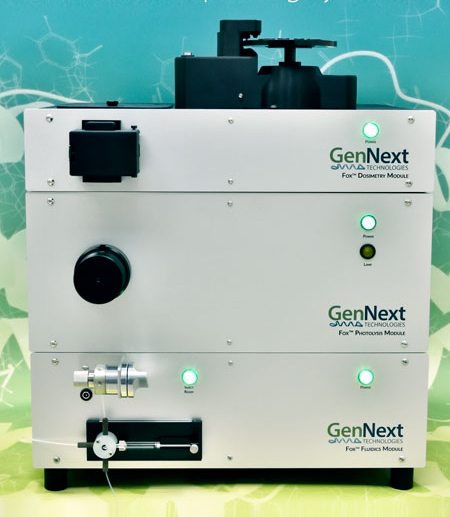Hydroxyl Radical Protein Footprinting (HRPF) Services in mAb Design & Production
HRPF is a powerful technique that is being used to generate high-value information for characterizing monoclonal antibodies (mAb) in the design and development of effective and safe biologics. Researchers are using this technique to study antigen-binding sites, epitope/paratope mapping, host antibody responses, antibody aggregation, and more.
GenNext Technologies is the first to develop a fully-commercialized HRPF benchtop instrument and software platform, the Flash Oxidation (Fox®) Protein Footprinting System. The novel and actionable data generated from the Fox System by the highly trained contract research team at GenNext is being leveraged in therapeutic mAb design and production.
MONOCLONAL ANTIBODY DESIGN
With high-resolution structural information for epitope and paratope mapping, customers are accelerating the rational design of therapeutics.
MONOCLONAL ANTIBODY PRODUCTION
Monitoring mAb structure during scale-up to ensure batch-to-batch structure stability over time is ensuring product shelf life and continued efficacy.
Advantages of HRPF for mAb Analysis
Elucidating In-Solution mAb Structure & Dynamics
Although high-resolution protein structure analysis techniques such as MX, NMR, and cryoEM offer important insights, these approaches are unable to monitor the structure and dynamics of mAb formulations in-solution because of their specific sample preparation requirements. For example, MX requires the crystallization of proteins, cryoEM is measured in the frozen state, and NMR typically requires high concentrations and cannot be applied to proteins larger than 100 kDa. These approaches may disrupt antibody structure, require high concentrations, or result in other conditions that inhibit the accurate determination of antigen binding or kinetics.
In comparison, the Fox System, which employs the HRPF approach, provides dynamic, in-solution structure and interaction information for a wide range of protein sizes, states, and concentrations, such as:
- HRPF provides structure information for 19 out of 20 amino acid side chains providing richer solvent accessibility information to the residue level.
- The stability of the HRPF label enables a flexible post-labeling workflow for your specific study. For example, glycans can be easily removed post-labeling allowing the study of highly glycosylated proteins. Also, a wide range of proteolytic enzymes and long LC gradients can be used during MS analysis to ensure proper coverage.
- The Fox System uses a patented method for measuring effective hydroxyl radical concentration that delivers highly controlled and reproducible data for greater confidence in the mAb structure.

Interview with Dr. Joshua Sharp on Characterizing the HOS of mAbs
Hear about his recent article on the Structural Investigation of Therapeutic Antibodies Using Hydroxyl Radical Protein Footprinting Methods and how GenNext is engineering new technologies to answer difficult HOS questions.

Dr. Joshua Sharp from the University of Mississippi and GenNext Technologies
Dr. Sharp is a world-renowned expert with more than 25 peer-reviewed articles and numerous lectures on biopharmaceutical HRPF. Publishing the first benchtop methods for HRPF, Dr. Sharp’s innovations included the use of UV photolysis of hydrogen peroxide for hydroxyl radical generation. Along with his role as Chief Technology Officer for GenNext, Dr. Sharp is also an Associate Professor of Pharmacology and Research in the Research Institute of Pharmaceutical Sciences at the University of Mississippi. Professor Sharp serves on multiple national and international advisory and review panels as an expert on protein and carbohydrate biophysical and structural analysis by mass spectrometry.

Fox Protein Footprinting Services for mAb HOS Analysis
Easily Explore the Advantages of HRPF Via Fox Services
You can take advantage of GenNext’s patented and novel Fox technology through our convenient contract services program. This streamlined services program is the fastest and most economical route to access this robust and state-of-the-art HOS analytical method.
Complement your traditional HOS methods or begin a totally new route to modern HOS analysis using GenNext’s services. We will deliver novel and actionable information regarding the 3D structure of your molecule to help you discover and build more effective and safer monoclonal antibody therapeutics.

Step One:
The Plan
Using a research collaboration model, together we will define a specific research strategy that facilitates the timely delivery of results. Regularly scheduled meetings enable collaborative review of experimental details and program refinement. All interactions are held under the strictest confidentiality to ensure the protection of your company’s proprietary data and intellectual property rights.

Step Two:
Study
GenNext’s applied research scientists will perform the HRPF experiment using the Fox System in its laboratory near San Francisco, California. Following enzymatic digestion to constituent peptides, the samples will be analyzed using LC-MS/MS.

Step Three:
Analysis
Finally, GenNext experts will investigate the MS data using our proprietary FoxWare® Software to provide a comprehensive report on the HOS insights generated by protein footprinting.
Just complete the short form on the right to view our toolkit and explore the potential of HRPF in your HOS studies.
MONOCLONAL ANTIBODY TOOLKIT
ON-DEMAND PRESENTATIONS
- HRPF for mAb Drug Development
- HRPF for mAb Aggregation
- Mapping the Paratope and Epitope of TNFα Bound to Adalimumab
- Review of Technologies for HOS Analysis
PAPERS & LITERATURE
- Structural Investigation of Therapeutic Antibodies Using Hydroxyl Radical Protein Footprinting Methods paper written by Dr. Corie Ralston of the Lawrence Berkeley National Laboratory and Prof. Joshua Sharp of The University of Mississippi and published in the journal Antibodies.
- Revealing Antibody Aggregation White Paper
- Mapping the Epitope of TNFα Bound to Adalimumab Poster Note
- Review of Technologies for HOS Analysis Tech Note
- GenNext Services FAQ
